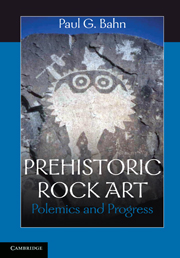Book contents
- Frontmatter
- Contents
- Figures
- Foreword by H. C. Woodhouse
- Acknowledgements
- Introduction
- 1 Art on the rocks
- 2 Myths and meanings
- 3 The emperor's new clothes I: sloppy tailoring
- 4 The emperor's new clothes II: fashion disasters
- 5 Location, location, location
- 6 The votive motive
- 7 Mustn't crumble
- Conclusion
- Select bibliography
- Index
Foreword by H. C. Woodhouse
Published online by Cambridge University Press: 05 June 2012
- Frontmatter
- Contents
- Figures
- Foreword by H. C. Woodhouse
- Acknowledgements
- Introduction
- 1 Art on the rocks
- 2 Myths and meanings
- 3 The emperor's new clothes I: sloppy tailoring
- 4 The emperor's new clothes II: fashion disasters
- 5 Location, location, location
- 6 The votive motive
- 7 Mustn't crumble
- Conclusion
- Select bibliography
- Index
Summary
In giving a name to his series of Rhind lectures, Dr Paul Bahn wisely chose the same title – Art on the Rocks – as I used in 1970 for a book on the rock art of southern Africa, written in collaboration with D. N. Lee of Johannesburg. I write ‘wisely’ because the title includes that all-important word ‘art’ with its numerous thought-provoking meanings and nuances.
Paul Bahn has, for many years, been among those who refuse to give one narrow reason or motivation to the art. He has agreed that art originated with those singular people whom we call artists and that artists come in all sizes and persuasions. They may include practitioners of various kinds such as ‘shamans’, but are not to be forced into shamanistic pigeonholes, but instead left free to satisfy their own inspiration with their own approach to life – and art.
The shortage (or nonexistence) of rock art departments has emphasised the lack of facilities at universities for the study of this important prehistoric resource – a study which Paul Bahn has pursued from his own motivation – so it is all the more praiseworthy that the Society of Antiquaries of Scotland invited him to deliver the Rhind lectures on this topic and that Cambridge University Press has agreed to publish them.
- Type
- Chapter
- Information
- Prehistoric Rock ArtPolemics and Progress, pp. xiii - xivPublisher: Cambridge University PressPrint publication year: 2010



